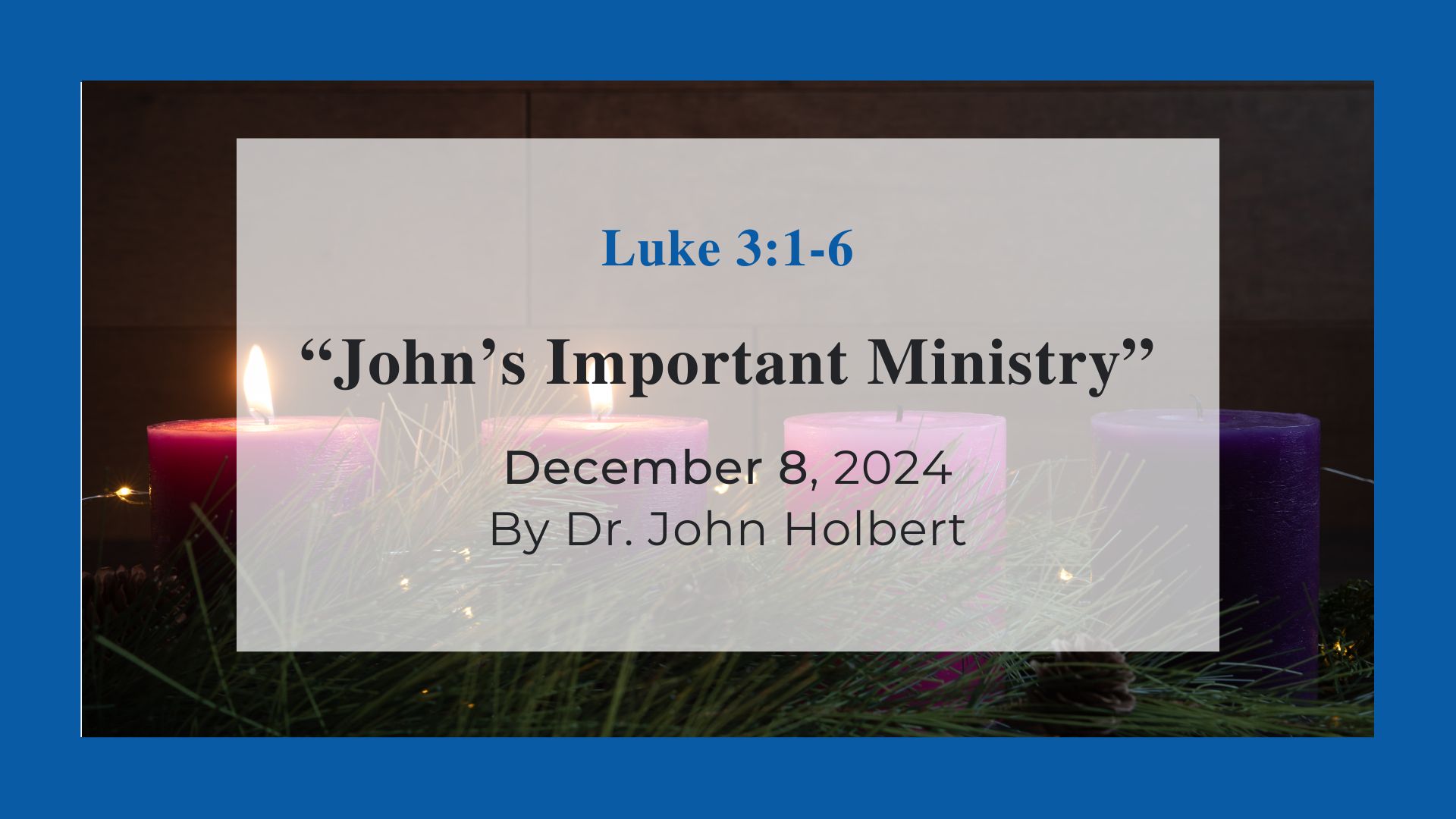John's Important Ministry - Reflections on Luke 3:1-6, Advent 2 Year C
by John Holbert on Thursday, November 28, 2024

John, known primarily as the precursor, the forerunner, of Jesus, also remembered as John the Baptizer, the man who baptized the Messiah in the Jordan as a kind of inauguration of his public ministry, is depicted quite differently in the Gospel of Luke. In Luke 3 we read a rather complete description of the quite extraordinary work of John, who, in this one Gospel, is not the one who baptized Jesus at all. Before Jesus was dipped (or perhaps sprinkled in the Methodist way?), John was “shut up in prison” by Herod Antipas, the “tetrarch of Galilee” (Luke 3:19). For Luke, Jesus is baptized only in a passive way by an unnamed actor (Luke 3:21). Luke’s alteration of the story of the baptism from Mark and Matthew has the effect of highlighting the work of John, separating it in time from the ministry of Jesus.
And the changes Luke makes to his sources further has the effect of emphasizing something his particular Gospel regularly focuses our attention on: the use of possessions as the clearest example of how we should respond to the presence of God in our lives. John is for Luke a prophet, very like the prophets of the Hebrew Bible, who were in the same way deeply concerned with how the material gifts of God are employed for the benefit of all persons, not merely for those who are blessed to have such gifts.
The opening six verses of chapter three, the only ones assigned by the lectionary collectors, begin this portrait of John, but we surely must take with equal seriousness the following language about John’s prophetic ministry. Luke may have been uniquely interested in giving John added descriptive space, since in Acts 19:3, in the second volume of Luke’s work, he reminds us that John still had disciples in Ephesus some 20 years after his death.
The story of John begins in typical Lukan fashion with some historical notes, often termed “synchronism” by scholars, wherein the immediate context is portrayed by reference to leading political leaders of the time. Luke 1:5 and 2:1 provide similar historical synchronisms. We here learn of the current Caeser’s rule (Tiberius’ 15th regnal year—ca. 28-29CE), the prefecture of Pontius Pilate in Judea (26-36CE), and the time of Herod Antipas, Herod the Great’s son, who was nominal ruler in Galilee until 39CE. Two of these, Pilate and Herod will of course play significant roles in the later tales of Jesus. With the general time frame established, we are then reminded of the origins of this John by referring to him as “son of Zechariah” from the story of Luke 1, the charming account of the births of both Jesus and John.
John’s ministry is performed “in the area all around the Jordan,” a rather vague description, but given the multiple references to Galilee, may indicate that John, like Jesus, worked primarily in the north of the country. To begin that work, John “announced (using a Greek word that can mean “preach”) a conversion baptism for the forgiveness of sins” (Luke 3:3). Such a forgiveness of sins fulfills the prediction of Gabriel concerning John (Luke 1:77), and becomes for Luke a prominent element of what he claims to be the good news (see 24:27; Acts 5:31; among others). John quotes more extensively than Mark and Matthew from Is.40:3-5, adding to them the engineering metaphor of royal road building that results from leveling mountains and filling in valleys, concluding with “all flesh shall see the salvation of God!”
And then Luke gives us an extensive series of examples of what it means truly to be converted. “Produce deeds appropriate to conversion,” he warns, and then says, “Do not start saying to yourselves, ‘Abraham is our father,’ thereby claiming that since we are heirs of the great patriarch, we are of course saved already. No, John shouts. “God can raise up children for Abraham out of these stones,” he says; there can be no more hiding behind “the chosen people” ideology, for God creates a people by the gift of the Spirit and by genuine faith. The specific examples of conversion are: anyone with two tunics must share one with anyone without a tunic; those with food must in the same way share it; tax agents can no longer attempt to gain wealth by demanding more than those taxed are required to give; soldiers cannot throw their martial power around to extort or blackmail anyone, and should be satisfied with their prescribed pay. These common examples of what must have been occurring among them John demonstrates to be signs of true conversion.
The sermon ends with a grim metaphor of the coming one who will “baptize you with the Holy Spirit and fire,” wielding “a winnowing fork ready to clear the threshing floor,” gathering the wheat but discarding and burning the chaff (Luke 3:8-17). The result of such fiery preaching is Herod’s anger and deep resentment against John, who had upbraided the tetrarch for his marriage to his brother’s wife among “all the evil things he had done” (Luke 3:19). All that activity earned John a time in prison. Of course, in Mark and Matthew we are told the grisly tale of John’s appalling murder in the prison at the request of Salome who demands his head on a platter; Luke has none of that. (If you desire a chilling operatic portrayal of that terrible narrative, look and listen to Richard Strauss’ “Salome;” not for the faint of heart, I assure you.)
Yes, John is forerunner of Jesus, but he, like Jesus, also had a significant ministry to perform in the region of Galilee, and Luke gives that to us with finely detailed and powerful images. We come away knowing what it is God requires of converted sinners, namely generosity, integrity, and genuine concern for the whole community.
